valve HONDA CLARITY FUEL CELL 2018 Owner's Manual (in English)
[x] Cancel search | Manufacturer: HONDA, Model Year: 2018, Model line: CLARITY FUEL CELL, Model: HONDA CLARITY FUEL CELL 2018Pages: 551, PDF Size: 27.22 MB
Page 14 of 551
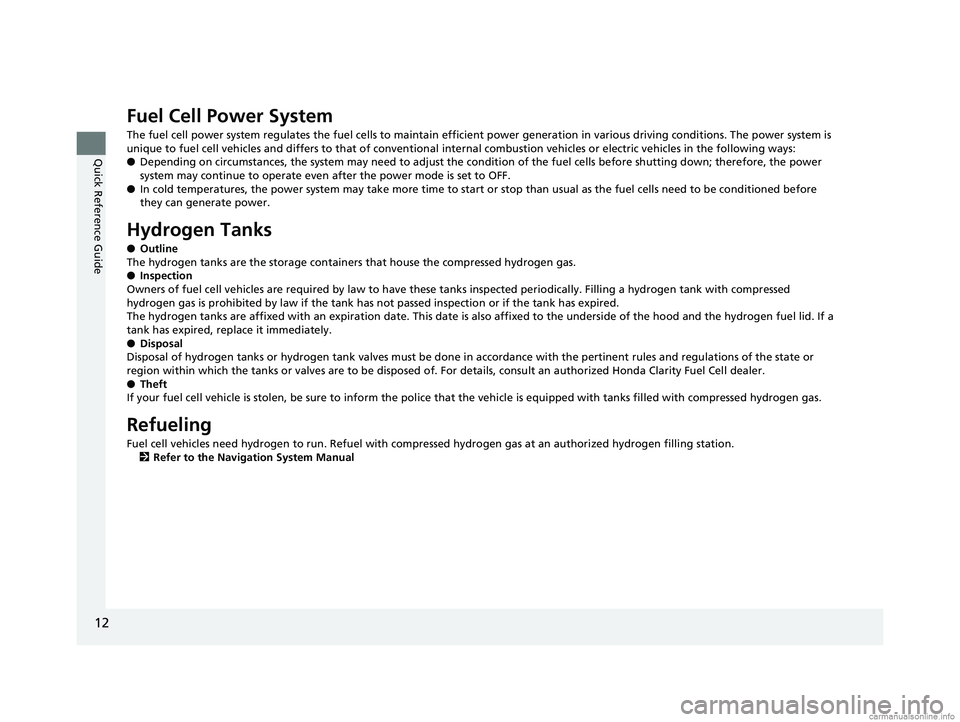
12
Quick Reference Guide
Fuel Cell Power System
The fuel cell power system regulates the fuel cells to maintain efficient power generation in various driving conditions. The p ower system is
unique to fuel cell vehicles and differs to that of conventional internal combustion vehicles or electric vehicles in the following ways:
● Depending on circumstances, the system may n eed to adjust the condition of the fuel cells before shutting down; therefore, the power
system may continue to operate even after the power mode is set to OFF.
● In cold temperatures, the power system may take more time to sta rt or stop than usual as the fuel cells need to be conditioned before
they can generate power.
Hydrogen Tanks
● Outline
The hydrogen tanks are the storage containe rs that house the compressed hydrogen gas.
● Inspection
Owners of fuel cell vehicles are required by law to have these tanks inspected periodically. Filling a hydrogen tank with compr essed
hydrogen gas is prohibited by law if the tank has not passed inspection or if the tank has expired.
The hydrogen tanks are affixed with an expiration date. This date is also affixed to the underside of the hood and the hydrogen fuel lid. If a
tank has expired, replace it immediately.
● Disposal
Disposal of hydrogen tanks or hydrogen tank valves must be done in accordance with the pertinent rules and regulations of the state or
region within which the tanks or valves are to be disposed of. For details, consult an authorized Honda Clarity Fuel Cell deale r.
● Theft
If your fuel cell vehicle is stolen, be sure to inform the polic e that the vehicle is equipped with tanks filled with compresse d hydrogen gas.
Refueling
Fuel cell vehicles need hydrogen to run. Refuel with compressed hydrogen gas at an authorized hydrogen filling station.
2 Refer to the Navigation System Manual
18 CLARITY FUEL CELL PPO-31TRT6100.book 12 ページ 2017年11月21日 火曜日 午後3時3分
Page 20 of 551
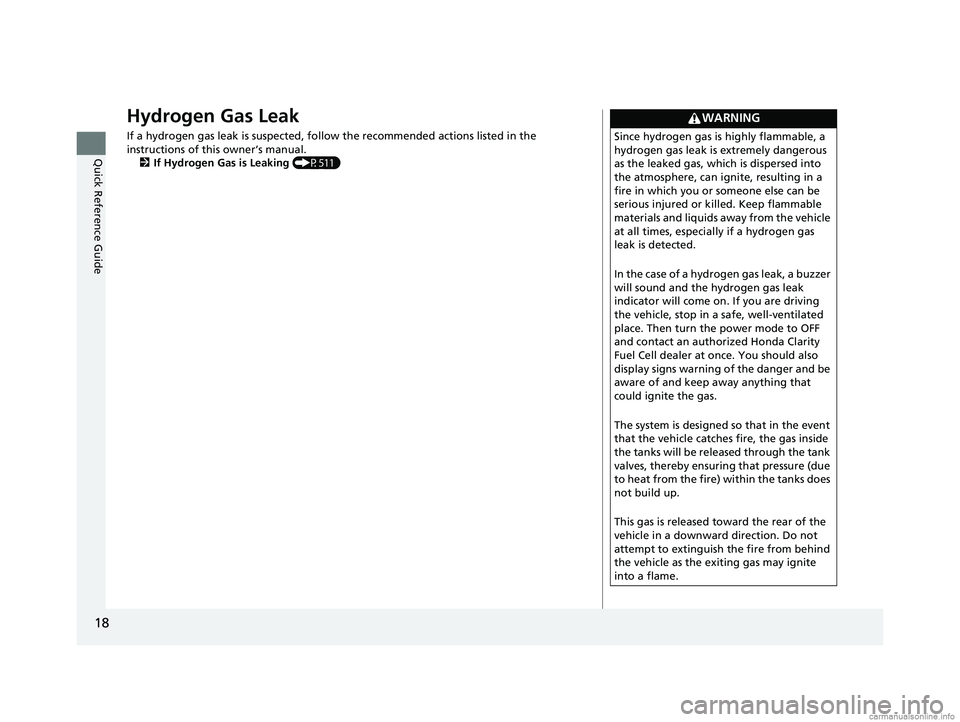
18
Quick Reference Guide
Hydrogen Gas Leak
If a hydrogen gas leak is suspected, follow the recommended actions listed in the
instructions of this owner’s manual. 2 If Hydrogen Gas is Leaking (P511)
WARNING
Since hydrogen gas is highly flammable, a
hydrogen gas leak is extremely dangerous
as the leaked gas, which is dispersed into
the atmosphere, can ignite, resulting in a
fire in which you or someone else can be
serious injured or killed. Keep flammable
materials and liquids away from the vehicle
at all times, especially if a hydrogen gas
leak is detected.
In the case of a hydrogen gas leak, a buzzer
will sound and the hydrogen gas leak
indicator will come on. If you are driving
the vehicle, stop in a safe, well-ventilated
place. Then turn the power mode to OFF
and contact an authorized Honda Clarity
Fuel Cell dealer at once. You should also
display signs warning of the danger and be
aware of and keep away anything that
could ignite the gas.
The system is designed so that in the event
that the vehicle catches fire, the gas inside
the tanks will be released through the tank
valves, thereby ensuring that pressure (due
to heat from the fire) within the tanks does
not build up.
This gas is released toward the rear of the
vehicle in a downward direction. Do not
attempt to extinguish the fire from behind
the vehicle as the exiting gas may ignite
into a flame.
18 CLARITY FUEL CELL PPO-31TRT6100.book 18 ページ 2017年11月21日 火曜日 午後3時3分
Page 23 of 551
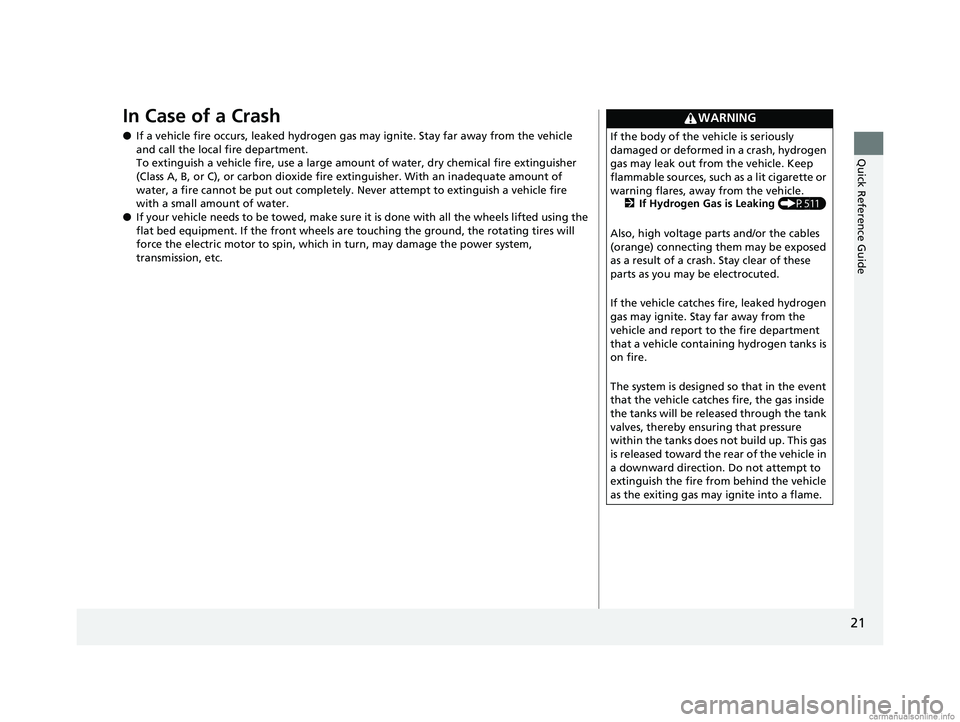
21
Quick Reference Guide
In Case of a Crash
●If a vehicle fire occurs, leaked hydrogen gas may ignite. Stay far away from the vehicle
and call the local fire department.
To extinguish a vehicle fire, use a large amount of water, dry chemical fire extinguisher
(Class A, B, or C), or carbon dioxide fire extinguisher. With an inadequate amount of
water, a fire cannot be put out completely. Never attempt to extinguish a vehicle fire
with a small amount of water.
● If your vehicle needs to be towed, make sure it is done with all the wheels lifted using the
flat bed equipment. If the front wheels are touching the ground, the rotating tires will
force the electric motor to spin, which in turn, may damage the power system,
transmission, etc.
WARNING
If the body of the vehicle is seriously
damaged or deformed in a crash, hydrogen
gas may leak out from the vehicle. Keep
flammable sources, such as a lit cigarette or
warning flares, away from the vehicle. 2If Hydrogen Gas is Leaking (P511)
Also, high voltage parts and/or the cables
(orange) connecting them may be exposed
as a result of a crash. Stay clear of these
parts as you may be electrocuted.
If the vehicle catches fire, leaked hydrogen
gas may ignite. Stay far away from the
vehicle and report to the fire department
that a vehicle containing hydrogen tanks is
on fire.
The system is designed so that in the event
that the vehicle catches fire, the gas inside
the tanks will be released through the tank
valves, thereby ensuring that pressure
within the tanks does not build up. This gas
is released toward the rear of the vehicle in
a downward direction. Do not attempt to
extinguish the fire from behind the vehicle
as the exiting gas may ignite into a flame.
18 CLARITY FUEL CELL PPO-31TRT6100.book 21 ページ 2017年11月21日 火曜日 午後3時3分
Page 470 of 551
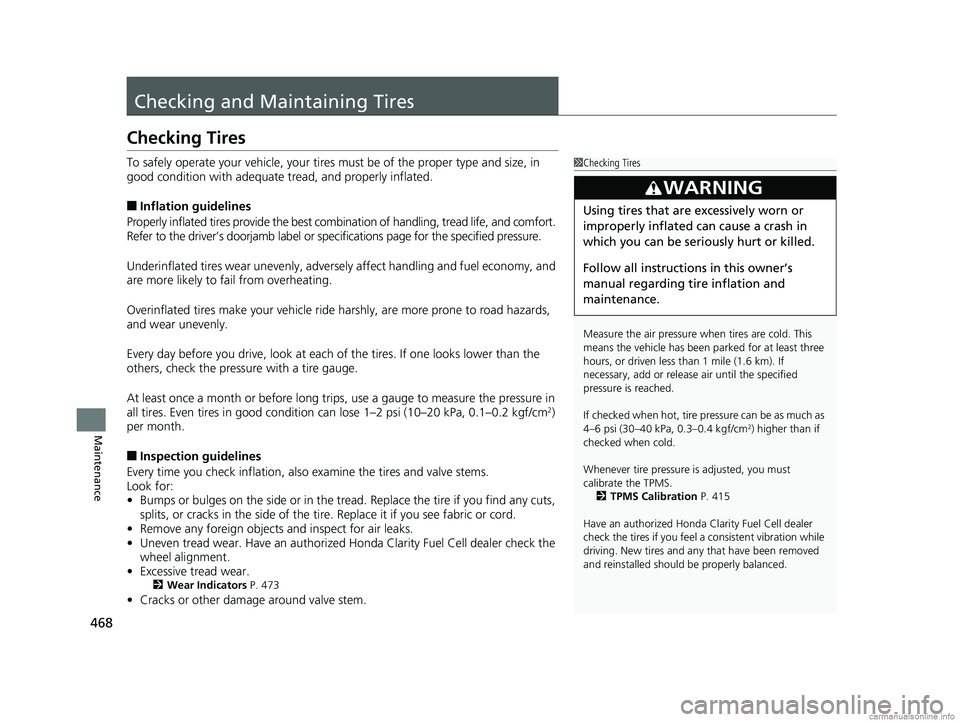
468
Maintenance
Checking and Maintaining Tires
Checking Tires
To safely operate your vehicle, your tires must be of the proper type and size, in
good condition with adequate tread, and properly inflated.
■Inflation guidelines
Properly inflated tires provide the best combination of handling, tread life, and comfort.
Refer to the driver’s doorjamb label or spec ifications page for the specified pressure.
Underinflated tires wear unevenly, adversely affect handling and fuel economy, and
are more likely to fail from overheating.
Overinflated tires make your vehicle ride harshly, are more prone to road hazards,
and wear unevenly.
Every day before you drive, look at each of the tires. If one looks lower than the
others, check the pressure with a tire gauge.
At least once a month or before long trips, use a gauge to measure the pressure in
all tires. Even tires in good condition ca n lose 1–2 psi (10–20 kPa, 0.1–0.2 kgf/cm
2)
per month.
■Inspection guidelines
Every time you check inflation, also examine the tires and valve stems.
Look for:
• Bumps or bulges on the side or in the tread. Replace the tire if you find any cuts,
splits, or cracks in the si de of the tire. Replace it if you see fabric or cord.
• Remove any foreign objects and inspect for air leaks.
• Uneven tread wear. Have an authorized Honda Clarity Fuel Cell dealer check the
wheel alignment.
• Excessive tread wear.
2 Wear Indicators P. 473
•Cracks or other damage around valve stem.
1Checking Tires
Measure the air pressure when tires are cold. This
means the vehicle has been parked for at least three
hours, or driven less than 1 mile (1.6 km). If
necessary, add or releas e air until the specified
pressure is reached.
If checked when hot, tire pressure can be as much as
4–6 psi (30–40 kPa, 0.3–0.4 kgf/cm
2) higher than if
checked when cold.
Whenever tire pressure is adjusted, you must
calibrate the TPMS. 2 TPMS Calibration P. 415
Have an authorized Honda Clarity Fuel Cell dealer
check the tires if you feel a consistent vibration while
driving. New tire s and any that have been removed
and reinstalled should be properly balanced.
3WARNING
Using tires that are excessively worn or
improperly inflated can cause a crash in
which you can be seriously hurt or killed.
Follow all instruction s in this owner’s
manual regarding ti re inflation and
maintenance.
18 CLARITY FUEL CELL PPO-31TRT6100.book 468 ページ 2017年11月21日 火曜日 午後3時3分
Page 495 of 551
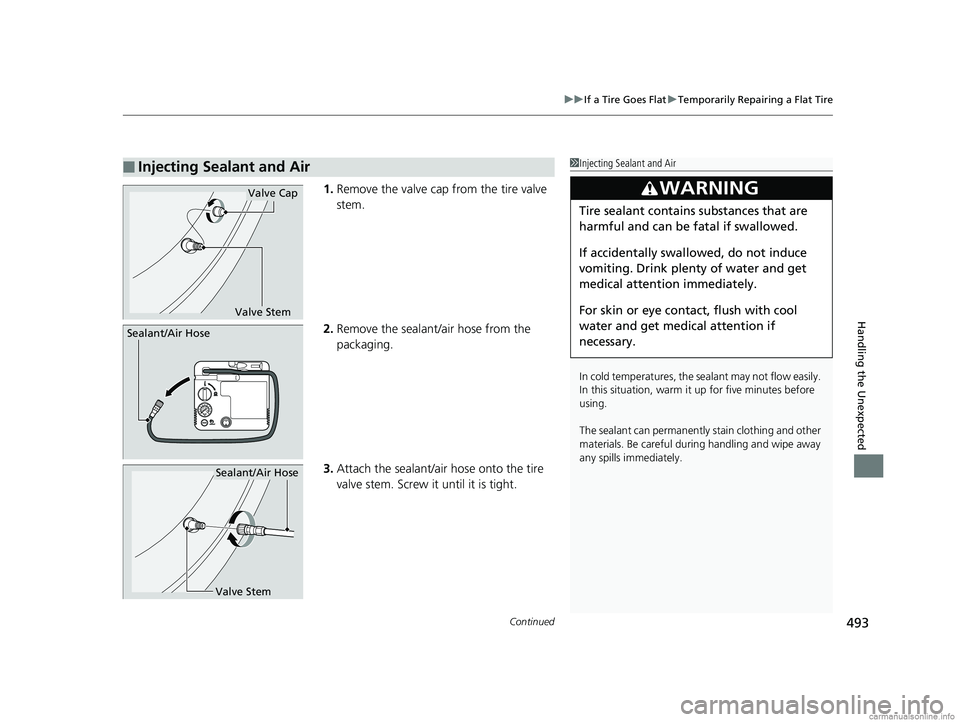
Continued493
uuIf a Tire Goes Flat uTemporarily Repairing a Flat Tire
Handling the Unexpected
1. Remove the valve cap from the tire valve
stem.
2. Remove the sealant/air hose from the
packaging.
3. Attach the sealant/air hose onto the tire
valve stem. Screw it until it is tight.
■Injecting Sealant and Air1Injecting Sealant and Air
In cold temperatures, the sealant may not flow easily.
In this situation, warm it up for five minutes before
using.
The sealant can permanentl y stain clothing and other
materials. Be careful duri ng handling and wipe away
any spills immediately.
3WARNING
Tire sealant contains substances that are
harmful and can be fatal if swallowed.
If accidentally swallowed, do not induce
vomiting. Drink plenty of water and get
medical attention immediately.
For skin or eye contact, flush with cool
water and get medical attention if
necessary.
Valve Stem
Valve Cap
Sealant/Air Hose
Valve Stem
Sealant/Air Hose
18 CLARITY FUEL CELL PPO-31TRT6100.book 493 ページ 2017年11月21日 火曜日 午後3時3分
Page 497 of 551
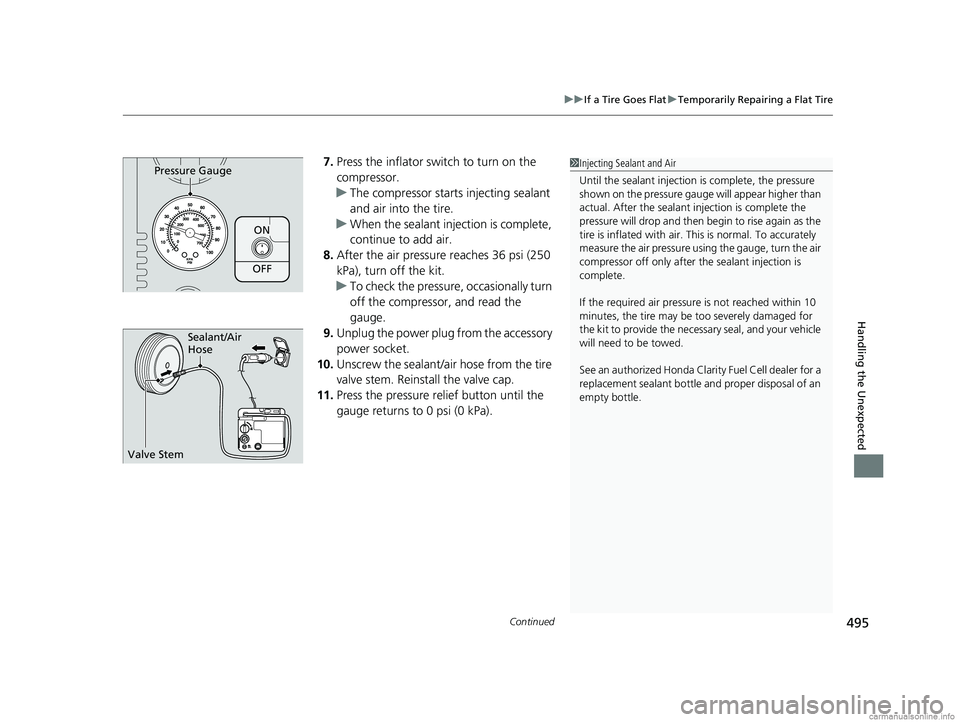
Continued495
uuIf a Tire Goes Flat uTemporarily Repairing a Flat Tire
Handling the Unexpected
7. Press the inflator switch to turn on the
compressor.
u The compressor starts injecting sealant
and air into the tire.
u When the sealant injection is complete,
continue to add air.
8. After the air pressure reaches 36 psi (250
kPa), turn off the kit.
u To check the pressure, occasionally turn
off the compressor, and read the
gauge.
9. Unplug the power plug from the accessory
power socket.
10. Unscrew the sealant/ai r hose from the tire
valve stem. Reinstall the valve cap.
11. Press the pressure relief button until the
gauge returns to 0 psi (0 kPa).
ON
OFF
Pressure Gauge1Injecting Sealant and Air
Until the sealant injection is complete, the pressure
shown on the pressure gauge will appear higher than
actual. After the sealant injection is complete the
pressure will drop and then begin to rise again as the
tire is inflated with air. This is normal. To accurately
measure the air pressure usi ng the gauge, turn the air
compressor off only after the sealant injection is
complete.
If the required air pressure is not reached within 10
minutes, the tire may be too severely damaged for
the kit to provide the necessa ry seal, and your vehicle
will need to be towed.
See an authorized Honda Clar ity Fuel Cell dealer for a
replacement sealant bottle an d proper disposal of an
empty bottle.
Sealant/Air
Hose
Valve Stem
18 CLARITY FUEL CELL PPO-31TRT6100.book 495 ページ 2017年11月21日 火曜日 午後3時3分
Page 500 of 551
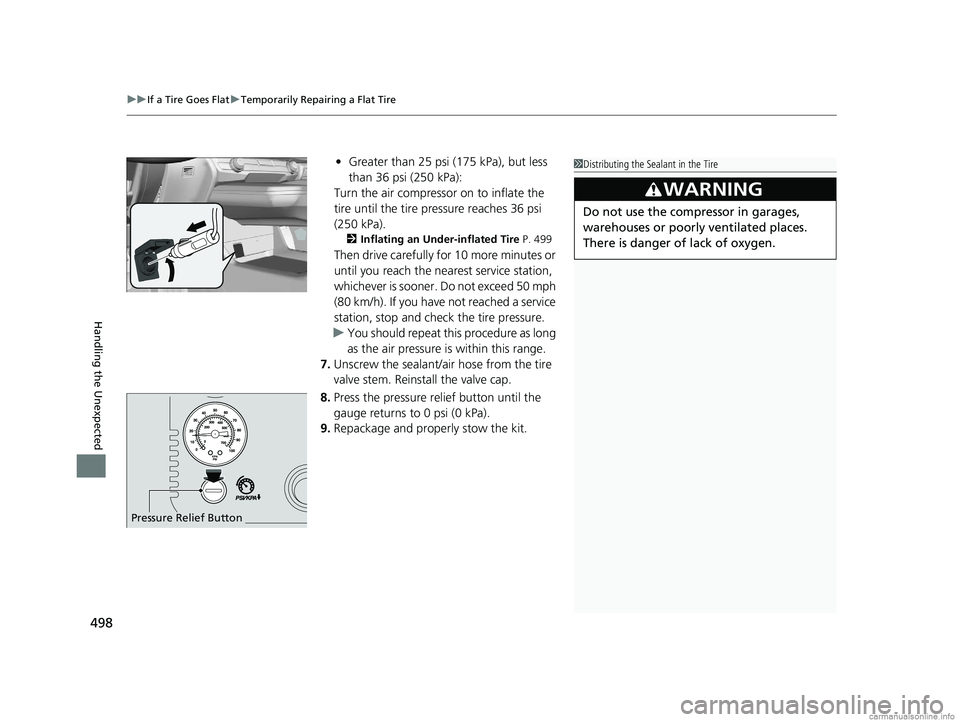
uuIf a Tire Goes Flat uTemporarily Repairing a Flat Tire
498
Handling the Unexpected
• Greater than 25 psi (175 kPa), but less
than 36 psi (250 kPa):
Turn the air compressor on to inflate the
tire until the tire pressure reaches 36 psi
(250 kPa).
2 Inflating an Under-inflated Tire P. 499
Then drive carefully for 10 more minutes or
until you reach the nearest service station,
whichever is sooner. Do not exceed 50 mph
(80 km/h). If you have not reached a service
station, stop and check the tire pressure.
u You should repeat this procedure as long
as the air pressure is within this range.
7. Unscrew the sealant/ai r hose from the tire
valve stem. Reinstall the valve cap.
8. Press the pressure relief button until the
gauge returns to 0 psi (0 kPa).
9. Repackage and properly stow the kit.
Pressure Relief Button
1Distributing the Sealant in the Tire
3WARNING
Do not use the compressor in garages,
warehouses or poorly ventilated places.
There is danger of lack of oxygen.
18 CLARITY FUEL CELL PPO-31TRT6100.book 498 ページ 2017年11月21日 火曜日 午後3時3分
Page 501 of 551
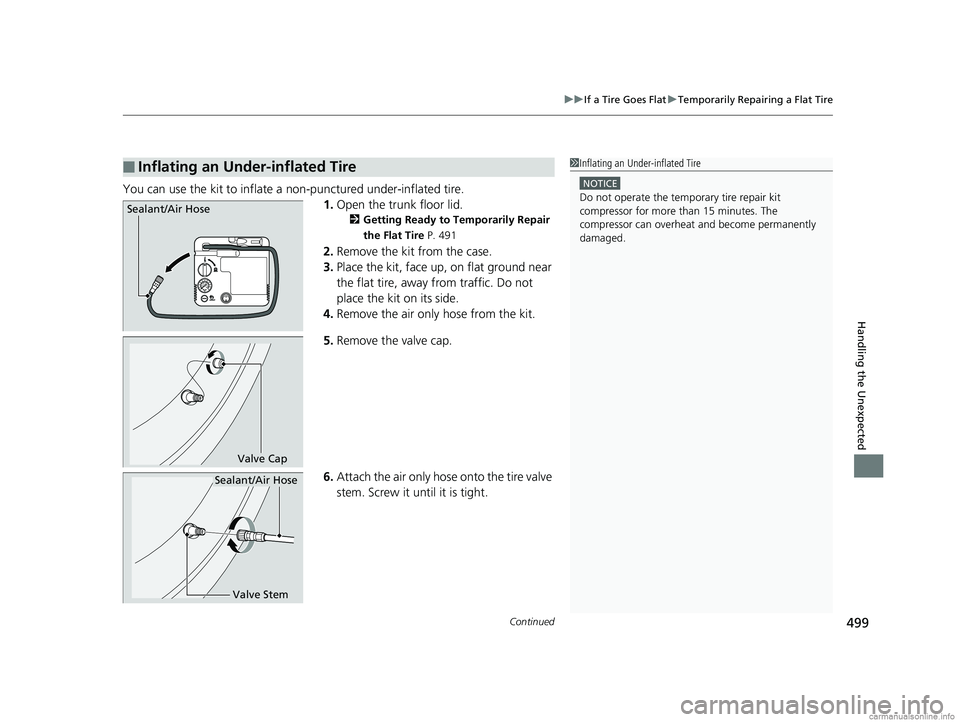
Continued499
uuIf a Tire Goes Flat uTemporarily Repairing a Flat Tire
Handling the Unexpected
You can use the kit to inflate a non-punctured under-inflated tire.
1.Open the trunk floor lid.
2 Getting Ready to Temporarily Repair
the Flat Tire P. 491
2.Remove the kit from the case.
3. Place the kit, face up, on flat ground near
the flat tire, away from traffic. Do not
place the kit on its side.
4. Remove the air only hose from the kit.
5. Remove the valve cap.
6. Attach the air only hose onto the tire valve
stem. Screw it until it is tight.
■Inflating an Under-inflated Tire1Inflating an Under-inflated Tire
NOTICE
Do not operate the temporary tire repair kit
compressor for more than 15 minutes. The
compressor can overheat and become permanently
damaged.Sealant/Air Hose
Valve Cap
Valve Stem
Sealant/Air Hose
18 CLARITY FUEL CELL PPO-31TRT6100.book 499 ページ 2017年11月21日 火曜日 午後3時3分
Page 503 of 551
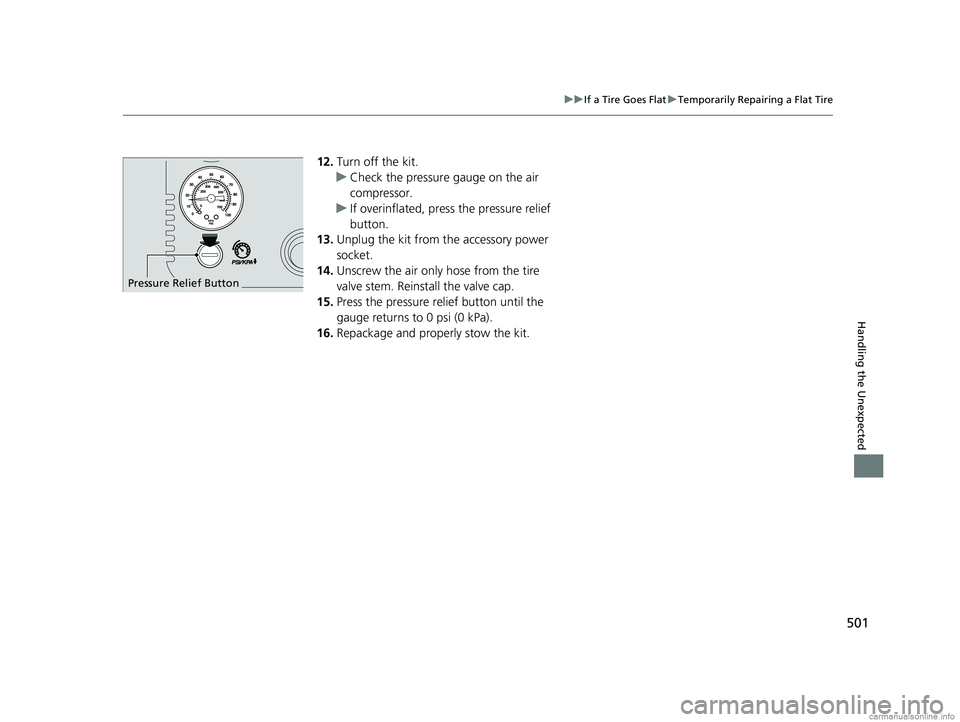
501
uuIf a Tire Goes Flat uTemporarily Repairing a Flat Tire
Handling the Unexpected
12. Turn off the kit.
u Check the pressure gauge on the air
compressor.
u If overinflated, press the pressure relief
button.
13. Unplug the kit from the accessory power
socket.
14. Unscrew the air only hose from the tire
valve stem. Reinstall the valve cap.
15. Press the pressure relief button until the
gauge returns to 0 psi (0 kPa).
16. Repackage and properly stow the kit.
Pressure Relief Button
18 CLARITY FUEL CELL PPO-31TRT6100.book 501 ページ 2017年11月21日 火曜日 午後3時3分
Page 513 of 551
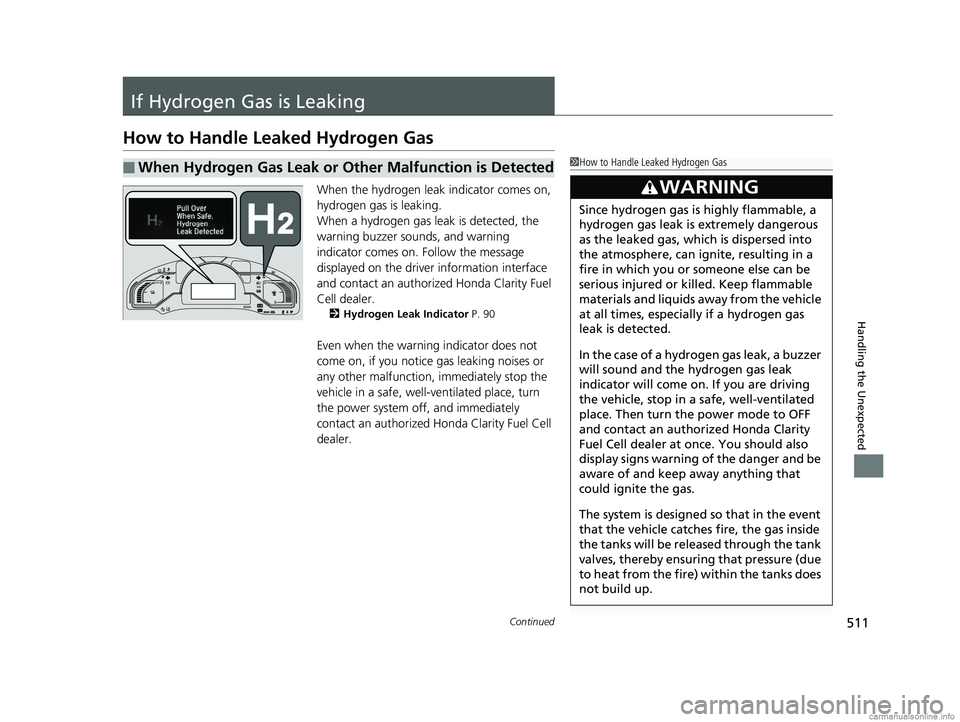
511Continued
Handling the Unexpected
If Hydrogen Gas is Leaking
How to Handle Leaked Hydrogen Gas
When the hydrogen leak indicator comes on,
hydrogen gas is leaking.
When a hydrogen gas leak is detected, the
warning buzzer sounds, and warning
indicator comes on. Follow the message
displayed on the driver information interface
and contact an authorized Honda Clarity Fuel
Cell dealer.
2 Hydrogen Leak Indicator P. 90
Even when the warning indicator does not
come on, if you notice gas leaking noises or
any other malfunction, immediately stop the
vehicle in a safe, well-ventilated place, turn
the power system off, and immediately
contact an authorized Honda Clarity Fuel Cell
dealer.
■When Hydrogen Gas Leak or Other Malfunction is Detected1 How to Handle Leaked Hydrogen Gas
3WARNING
Since hydrogen gas is highly flammable, a
hydrogen gas leak is extremely dangerous
as the leaked gas, which is dispersed into
the atmosphere, can ignite, resulting in a
fire in which you or someone else can be
serious injured or killed. Keep flammable
materials and liquids away from the vehicle
at all times, especially if a hydrogen gas
leak is detected.
In the case of a hydrogen gas leak, a buzzer
will sound and the hydrogen gas leak
indicator will come on. If you are driving
the vehicle, sto p in a safe, well-ventilated
place. Then turn th e power mode to OFF
and contact an author ized Honda Clarity
Fuel Cell dealer at once. You should also
display signs warning of the danger and be
aware of and keep aw ay anything that
could ignite the gas.
The system is designed so that in the event
that the vehicle catche s fire, the gas inside
the tanks will be released through the tank
valves, thereby ensuring that pressure (due
to heat from the fire) within the tanks does
not build up.
18 CLARITY FUEL CELL PPO-31TRT6100.book 511 ページ 2017年11月21日 火曜日 午後3時3分